Tag: Viognier
Planting the Vineyard, Part I
With the trellis posts finally in the ground, we were finally ready to plant. And not a moment too soon.
When we arrived in Afton on Friday evening, March 30, we had 50 dormant vines waiting for us: 25 Petit Manseng from Vintage Nurseries in Wasco, California, and 25 Viognier from Sunridge Nurseries, Bakersfield, California. The largest number of vines we had ever planted before was seven, and we weren’t sure how long it would take to get
these vines in the ground, or even if we’d be able to get it done by the end of the weekend. But we had another 100 vines set to arrive the following weekend, which meant we didn’t have much of a choice. We decided to plant the Petit Manseng first, and prepared them by putting them in a bucket of water to soak overnight.
In the morning, we inspected the vines to see if they looked healthy. This was kind of like the time in high school when my car wouldn’t start as I was taking my date home. I opened the hood, looked inside as though I knew what I was doing, and just prayed it would start when I got back in the car. It did start up, Continue Reading–>
Dormant Winter Pruning — and other Vineyard Considerations
After a long winter that sometimes seemed like it would never end, spring planting is just around the corner. And despite all the time we had to prepare for the new season, we are now feeling not quite as ready as we’d like to be.
We’ve ordered 150 vines –50 Petit Verdot, 50 Cab Franc, 25 Viognier and 25 Petit Manseng – and lately I’ve been waking up in the middle of the night wondering if we’ll have everything in place in time to plant. I’m still worried, but we’ve made enough progress lately, especially this weekend, that I’m feeling a bit better about the whole enterprise.
Our biggest concern is the trellis. If you’ve followed our progress through this blog, you’ll note that I didn’t worry about that last Spring when we planted 14 vines, split between our Fairfax and Nelson county properties, but that was different on a couple of counts. First, those vines were more for our education than for the eventual production of wine. And we’ve learned a lot from taking care of those vines. Wine in two years would be a bonus, but it wasn’t the goal when we planted them. The second reason I didn’t obsess over the trellis is that I didn’t expect those vines to reach the height of the first wire in that initial year. And since there are so few Continue Reading–>
Bringing in the Grapes – Part III
I received a note today from Kirsty Harmon, winemaker and general manager at Blenheim Vineyards, and I thought I would draw from it to add a little bit to my last post. Kirsty was kind enough to take time out from this most difficult harvest to talk with our class, even though we had barely harvested as much, between the entire group, as a single member of a field crew would have picked in, oh, maybe 15 minutes? Remember, I did say in Part II
that we spent a lot of time staring at the vines, wanting to be sure that we didn’t add bad fruit to the lugs or leave good fruit on the ground.
In any event, we were working on half a section of Viognier that day. Kirsty had told us that they picked the first half a week earlier, due to advanced ripening at the top of the hill and indications that sour rot was starting to set in. Since it was clear that rain was on the way, Blenheim picked the first section which had ripened early, and let the rest hang on in the hope that it would continue to gain sugar and flavor.
The two types of rots that appeared on the grapes in the second section – Botrytis and sour rot – both make grapes mushy (both leak juice with a vinegary odor), and so by the time they would have made it back to the sorting table, they would have leaked all over he good fruit.
“Field sorting is labor intensive, but worthwhile,” Kirsty said. “I would say that many
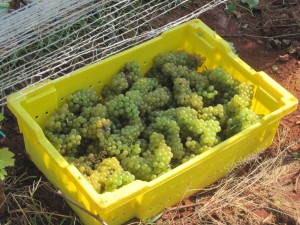
- We weren't very fast, but the fruit we added to the lugs sure looked good! Can't wait to taast the wine. 2011 Viognier.
wineries do take the time to do it though. Lots of wineries pick into bins rather than lugs, and not all wineries have the ability to sort when the fruit is picked into the half ton bins.”
You can see from the pictures in my last post how small lugs are. They are meant to bring grapes back to the crush pad or sorting table in good condition, without the weight of too many clusters at the top crushing those on the bottom.
Blenhein has almost completed its harvest. It has a small amount of Cab Franc remaining to be picked at the vineyard, and a few varieties in the Shenandoah Valley vineyards that it sources grapes from. You can bet that every winemaker and every vineyard manager will be glad to have all their fruit off the vine and into the fermentation tanks. It’s been that kind of year.
“This vintage has been the most challenging one of my career in Virginia,” said Kirsty. I think that almost every vineyard in the Commonwealth – and probably a good many in California as well – would agree.
In Search of a Few Good Vines
Now that we know what kinds of grapes we want to grow, it’s time to get down to the serious business of ordering vines and getting ready for spring planting. (Actually, this whole process has been serious business, but since the selection of grape varieties mostly involved visiting wineries and tasting wine, this part of the effort is serious in a somewhat different way.)
We began with some research on what clones have done well in Virginia. When you order vitis vinifera wines (which encompasses the European-style grapes most people are most familiar with, from Chardonnay to Cabernet Sauvignon), you’re making two decisions for each variety – the type of rootstock to use and the clone that will be grafted onto it. At a minimum, it’s important that rootstocks be resistant to such pests as phylloxera, the root louse that all but destroyed European vineyards in the 19thcentury, and nematodes, but we’re also looking for roots that will inhibit excessive growth, withstand cold winters, and work well in our soil, which is clay and loam. Long story short, we’ve pretty much decided to go with a root stock known as 101-14, the same root stock on the Cab Franc vines we’ve already planted in both the Fairfax and Nelson County vineyards.
Clones are more interesting, and they took a bit more time to figure out. Keep in mind that grape vines reproduce asexually. Cuttings from a Cab Franc are used to produce more Cab Franc
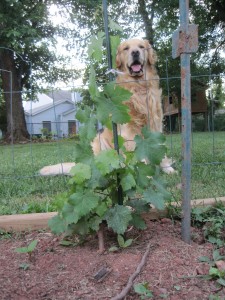
Here's a Cab Franc vine in the Fairfax vineyard (with Phoenix the Vineyard Dog standing guard) The clone is FPS 4, grafted onto 101-14 rootstock. The picture was shot a few months after planting.
vines, and it is presumed that the clone will exhibit the same qualities and characteristics as the vine it was taken from. But variations occur, and if a new vine exhibits differences that are deemed to be desirable, it may be characterized as a new clone and propagated more widely. So there isn’t just a single Viognier or a lone Cab Franc. There are a number of different Cab Francs, each classified as a separate clone, and each exhibiting different qualities, not just in the way they grow, but in the quality of the wine they produce.
So the choice of clones was very important to us. We relied heavily on Tony Wolf’s indispensible book,Wine Grape Production in Eastern North America, and came up with the following oddly-named clones (actually, all clones are oddly named; they sound a bit like the parts in an erector set) : For Cab Franc: ENTAV 214, 327, or 623 (whichever one we can get); for Petit Manseng: ENTAV 573; Petit Verdot, ENTAV 400, and Viognier: ENTAV 642. I mentioned Merlot in my last post, but we’ve pretty much decided that’s a clone too far for this year.
You can see that the clones we are most interested in all have the word ENTAV in their name. ENTAV (which stands for, Etablissement National Technique pour l’Amelioration de la Viticulture, or National Educational Association for Viticultural Improvement) are grapes of French origin, and sold in the United States through licensed nurseries. (By contrast, the clones we purchased early this year, referenced in the caption above, are FPS, which stands for Foundation Plant Services, the UC-Davis department that produces, tests, maintains and distributes premium foundation-level virus & disease-tested plant materials for use by California nurseries.)
We called one of the nurseries a few days ago, assuming that when we told them we planned to order a whopping 125 vines that they would fall all over themselves to help us, perhaps even offering to fly us out to California to get a look at the nursery. (You know I’m kidding, right? I would guess that their average order is measured in multiples of a thousand vines.) Our actual assumption is that we’d be able to get someone on the phone who could talk to us for a couple of minutes and then take our order and credit card number.
The nursery was Sunridge, which seems to be one of the very best in California, and the woman who worked with us could not have been friendlier or more helpful. Unfortunately, they didn’t have most of what we wanted. It turns out that they didn’t develop most of what we wanted “on spec” this year.
“On spec” seems to mean roughly the same thing in the grape vine nursery business as it does in the housing industry, where developers either build to order for a buyer who puts money down in advance, or build on spec in the hopes that buyers will show up with cash in hand. Whatever the case, they had the Viognier clones, but nothing else among our favorites.
Okay, that was a surprise. We had just assumed that everything on the web site would be immediately available and that all we had to do was call and ask for what we wanted. Now we are wondering if we will have to settle for clones that aren’t exactly what we want or wait another year to get clones of our dreams. Given that it takes a minimum of three years before the vines begin producing grapes, and a year or more after that before the wine is ready to drink, you only have so many chances in a single lifetime to get it right. And in our case, we only have so much land to devote to this enterprise. Putting off the planting for a year is not an option.
My wife, the Vineyard Goddess, sprang into action, and promptly identified a number of nurseries that distribute the varieties of grapes that we’re looking for. Great news! The bad news, however, was that only a handful sold the ENTAV clones we’re looking for.
We knew that there are only a limited number of ENTAV-approved nurseries in the United States, but we didn’t know how limited that number was. It turns out that only four nurseries in the U.S. are licensed to sell ENTAV clones, and two of them appear to have merged. Of the remaining two, one doesn’t have a web site, which is making it difficult to contact them, and the fourth has been a bit slow in getting back to us.
We think there might be other options, including Mercier California. According to the National Grape Registry, which is hosted by UC-Davis, Mercier has a presence in California. However, Mercier’s web site is tout en francias, and we are wondering if their ENTAV vines are shipped from France. Not that I care where they are shipped from. However, I do care about shipping costs. A friend who spent most of his life working vineyards in Bordeaux highly recommended Mercier, so we are hopeful that this is a viable option.
Okay, apparently purchasing vines isn’t as simple as logging into Amazon and selecting one-day shipping. But most of the things in life that are worthwhile require some extra work. And if anything warrants extra labor, it’s good wine. We’ll keep at it until we get it right. And with luck, we’ll be ordering those vines next week!
Outsmarting Birds and other Vineyard Predators
The grapes at DuCard Vineyards are starting to ripen nicely, which means that pretty much every creature that walks, flies or crawls is out to feast on them.
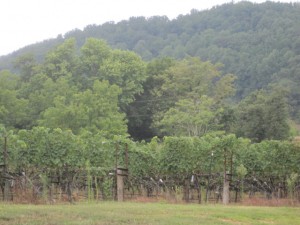
DuCard Vineyards in mid-August. The Cab Franc grapes are looking beautiful. Should be another great vintage for DuCard
There’s an old saying that goes something like this: when the deer begin eating the grapes, the Brix (a measure of the sugar level) is 20, when the birds begin feeding, it’s 22, and when the bees go after grapes, it’s time to harvest. (If anyone has a more accurate take on that little bit of country wisdom, please post a comment!)
That aphorism probably ascribes a level of precision to nature that can’t be verified with scientific instruments, but it does give you an idea of what the grape farmer is up against. After a growing season in which the vines are threatened by any one of a dozen pests or diseases, not to mention the vagaries of weather, Mother Nature presents a whole new set of challenges just as the grapes are reaching perfection.
Saturday’s vineyard management class at DuCard focused on a number of these problems, and some of the tried and true solutions that have been used by viticulturists for years. Some are high tech, like the box that transmits sounds of birds in distress throughout the vineyard, and others are decidedly low-tech: balloons and CDs hanging from trellises in spots where they’ll catch a bit of sunlight. All three seem to work pretty well.
Birds apparently have some early warning systems. They understand the vineyard is supposed to look a certain way, and when they see something out of the ordinary, they look for safer pastures, so to speak. The CDs catch a glint of sunlight, and are visible to the birds as they approach, sending off the signal
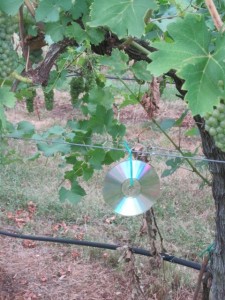
Any old song will do: Not sure if it matters which CDs we hang from the vines, they all seem to scare the birds.
that something is not quite right here, so move on, and be quick about it. The balloons accomplish the same thing. In other vineyards, I’ve seen foil streamers flying in the breeze, which has the same effect.
And the deer will be coming soon as well. DuCard is located in the midst of open country, some of the most beautiful country you’ll ever see, and so it’s home to more deer than any of us can count. The electric fence is going up this week, and between the fence, the balloons and the CDs, Scott thinks he has “about a 95 percent solution,” which I think is a nice compromise with nature.
While walking through the vineyard Saturday, I tasted a few Cab Franc and Viognier grapes, and was impressed by the sweetness. We’re getting toward the end of the period of veraison, the time in which the berries stop growing in size and begin ripening, turning color in the process. The Cab Franc gapes, for example, were about 80 percent there (by my own seat-of-the-pants measurement), with most of the grapes blue-black in color, and only a few still greenish. They’re looking magnificent, and the growing sugar level was evident on my tongue when I tasted the grapes.
As we move toward harvest, the sugar will continue to increase and acidity will drop. The seeds inside the grape will turn color from their current green to more of a brown, and will lose their bitterness. Soon, Scott Elliff, DuCard’s owner, and Julien Durantie, his vineyard manager, will begin testing the grapes regularly, taking advantage of both technology (checking the Brix with a refractometer), and the knowledge that comes from years of working in vineyards (looking at the seeds, chewing the skin to get an idea of the tannins, etc.)
The day of the harvest can’t be predicted this far in advance, and of course each of the four varieties of grapes Scott grows will ripen at different times. But at some point for each, everything will come together, and Scott will make the judgment that it’s time to get the grapes off the vine and onto the crush pad.
And then we can start dreaming about the wine.
Canopy Management, Part II
Here’s some pictures from the weekend class at DuCard Vineyard, thanks to classmate Margaret Frazier, who I have no doubt will one day soon be producing very high quality Virginia wines.
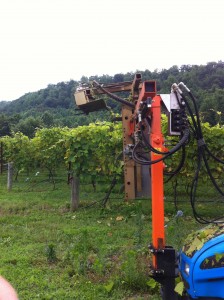
This is the hedger used to trim the tops of the vines in the lyre trellis. It's a bit hard to tell, but the arm of the hedger has whirling blades on both sides, which cuts one arm of the vines.

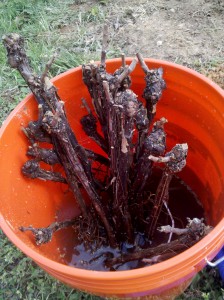
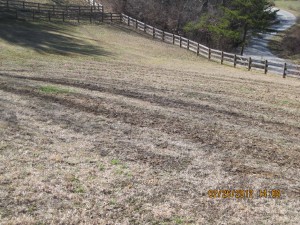
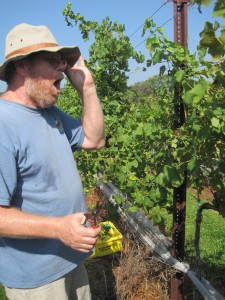
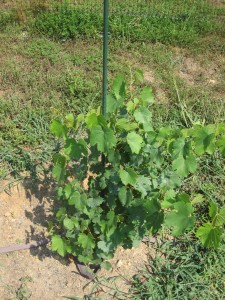
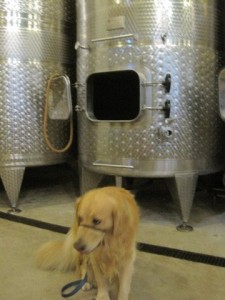
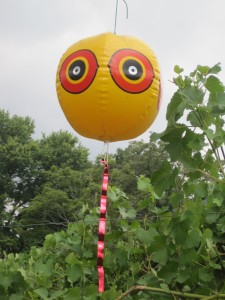
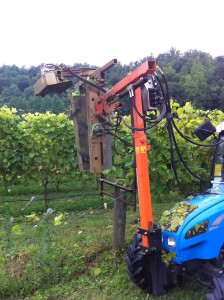
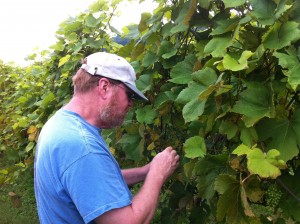
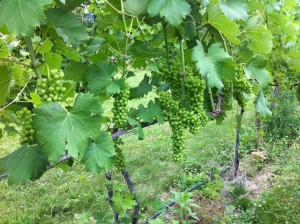


Recent Comments